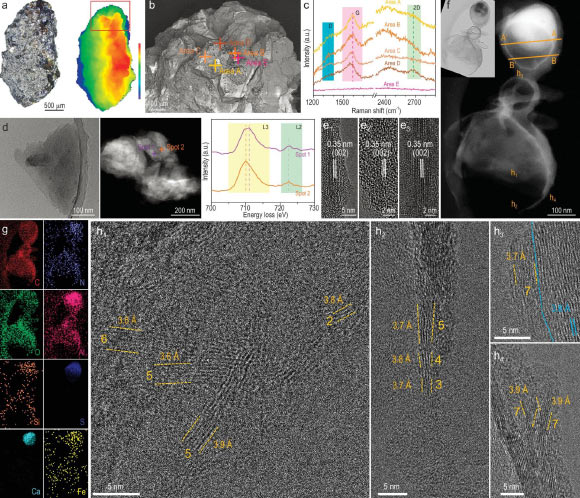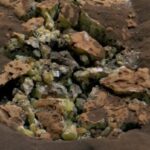In lunar regolith samples collected by China’s Chang’e-5 probe, planetary scientists have identified few-layer graphene formed together with complex minerals. The finding provides new insights into the origin of the Moon, supporting the hypothesis of a carbon-containing Moon.
Structural and compositional characterization of few-layer graphene in the Chang’e-5 lunar soil sample. Image credit: Zhang et al., doi: 10.1093/nsr/nwae211.
“Graphene has revolutionized the research of condensed matter physics and materials science with its novel physical phenomena and extraordinary properties,” said Jilin University Professor Wei Zhang and colleagues.
“It plays an increasingly important role in extensive areas including planetary and space science.”
“It is estimated that around 1.9% of total interstellar carbon is in the form of graphene and protosolar graphene has been identified in carbonaceous chondrite meteorites.”
The researchers analyzed an olive-shaped sample of lunar soil, about 2.9 mm by 1.6 mm, collected by the Chang’e 5 mission in 2020.
Using a special spectrometer, they found an iron compound that is closely related to the formation of graphene in a carbon-rich section of the sample.
They then used advanced microscopic and mapping technologies to confirm that the carbon content in the sample comprised ‘flakes’ that have two to seven layers of graphene.
The scientists proposed that the few-layer graphene may have formed in volcanic activity in the early stages of the Moon’s existence, and been catalyzed by solar winds that can stir up lunar soil and iron-containing minerals that helped transform the carbon atoms’ structure.
Meteorite impacts, which create high-temperature and high-pressure environments, may also have led to the formation of graphene.
“This is the first study to verify the presence of natural few-layer graphene in lunar soil samples by examining its microstructure and composition,” the authors said.
“Our finding provides new insights into the origin of the Moon, supporting the hypothesis of a carbon-containing Moon.”
“Moreover, the exotic properties of graphene are highly structurally and environmentally dependent.”
“Further in-depth property investigation of natural graphene would provide more information on the geologic evolution of the Moon.”
“In turn, the mineral-catalysed formation of natural graphene sheds light on the development of low-cost scalable synthesis techniques for high-quality graphene.”
“Therefore, a new lunar exploration program may be promoted and some forthcoming breakthroughs can be expected.”
The findings were published in the journal National Science Review.
_____
Wei Zhang et al. Discovery of natural few-layer graphene on the Moon. National Science Review, published online June 17, 2024; doi: 10.1093/nsr/nwae211




